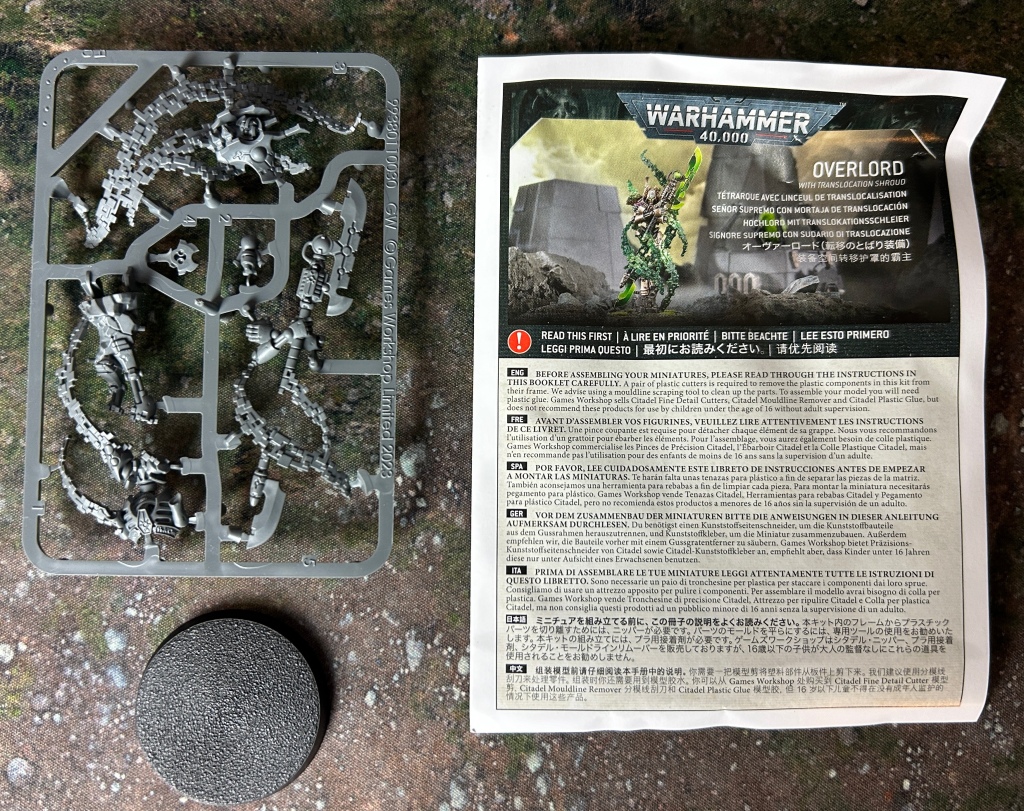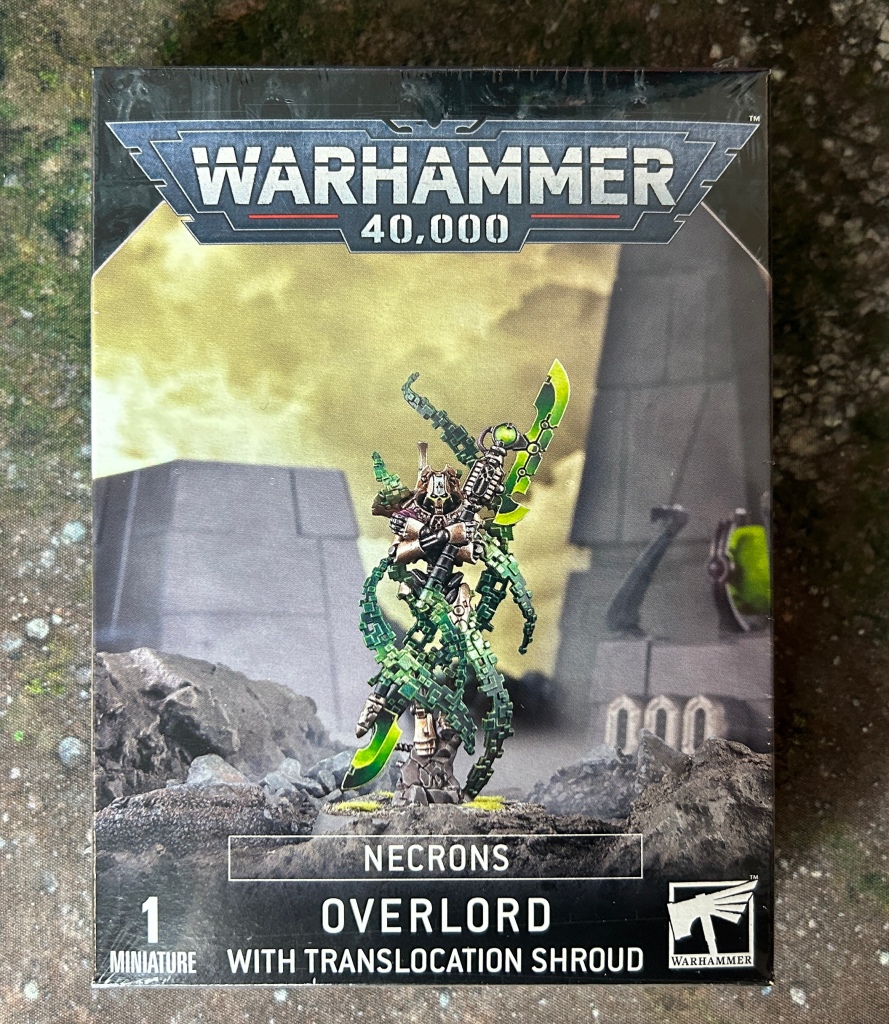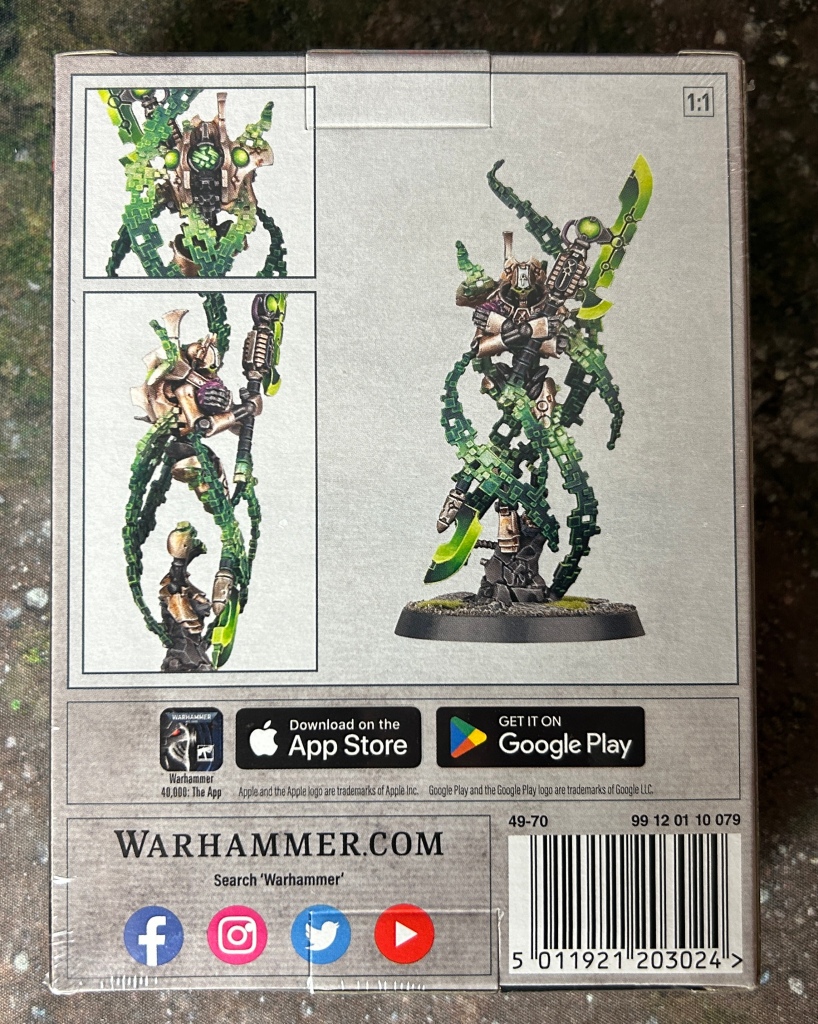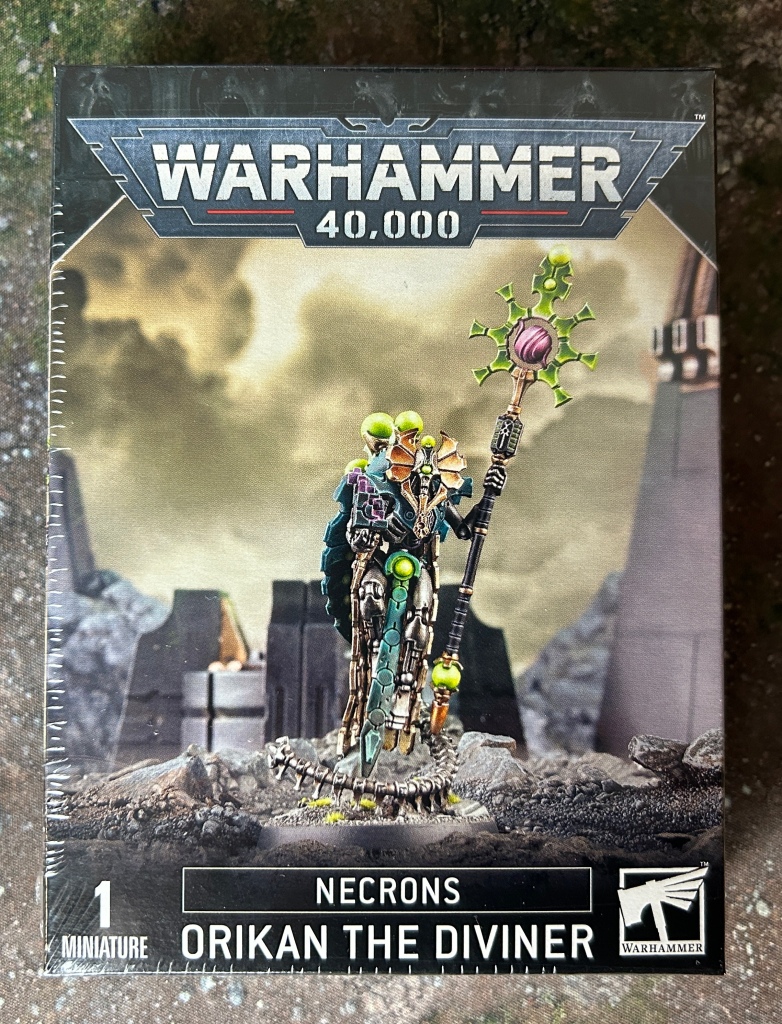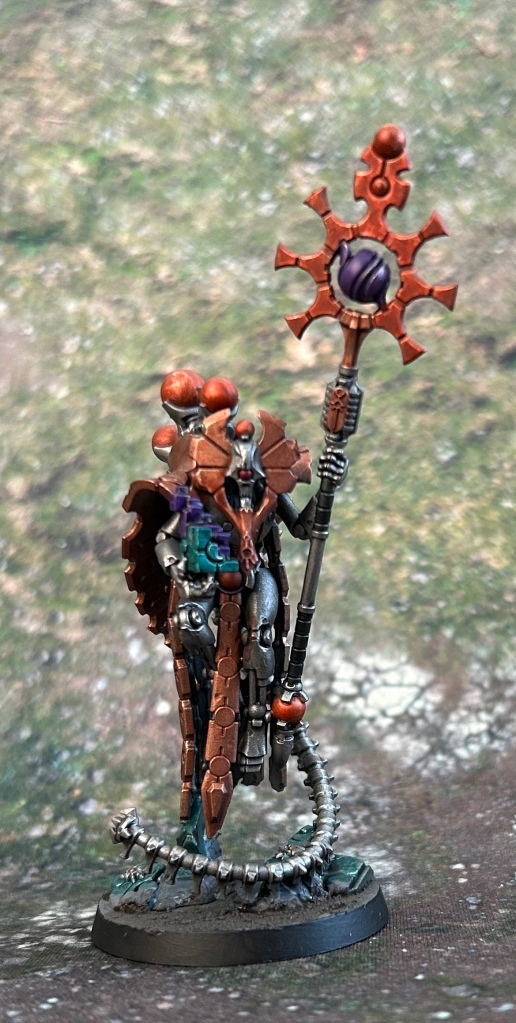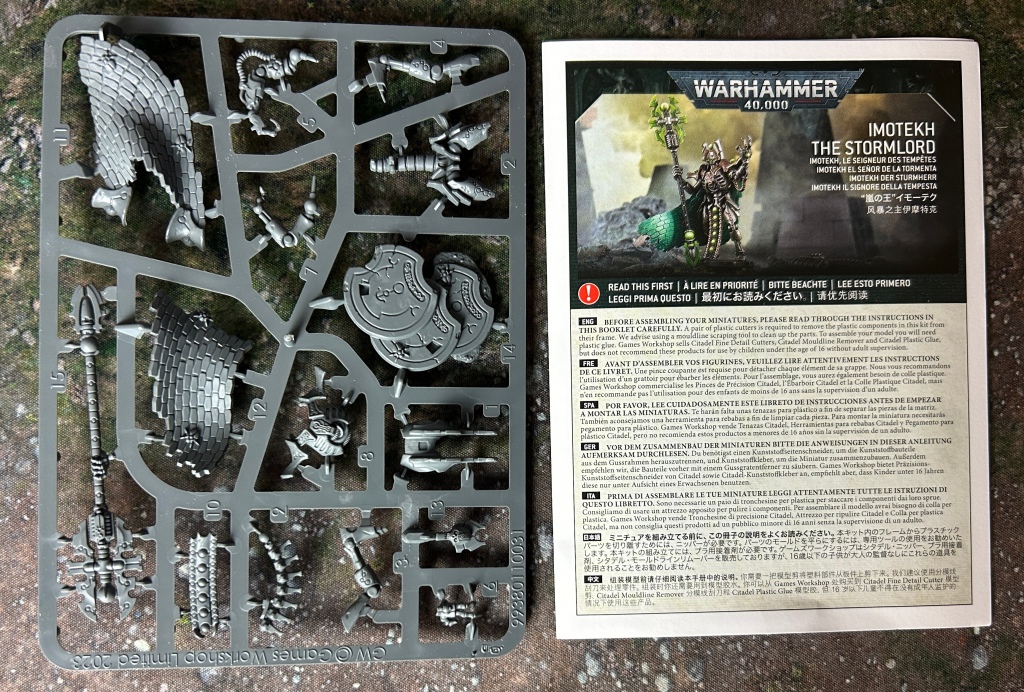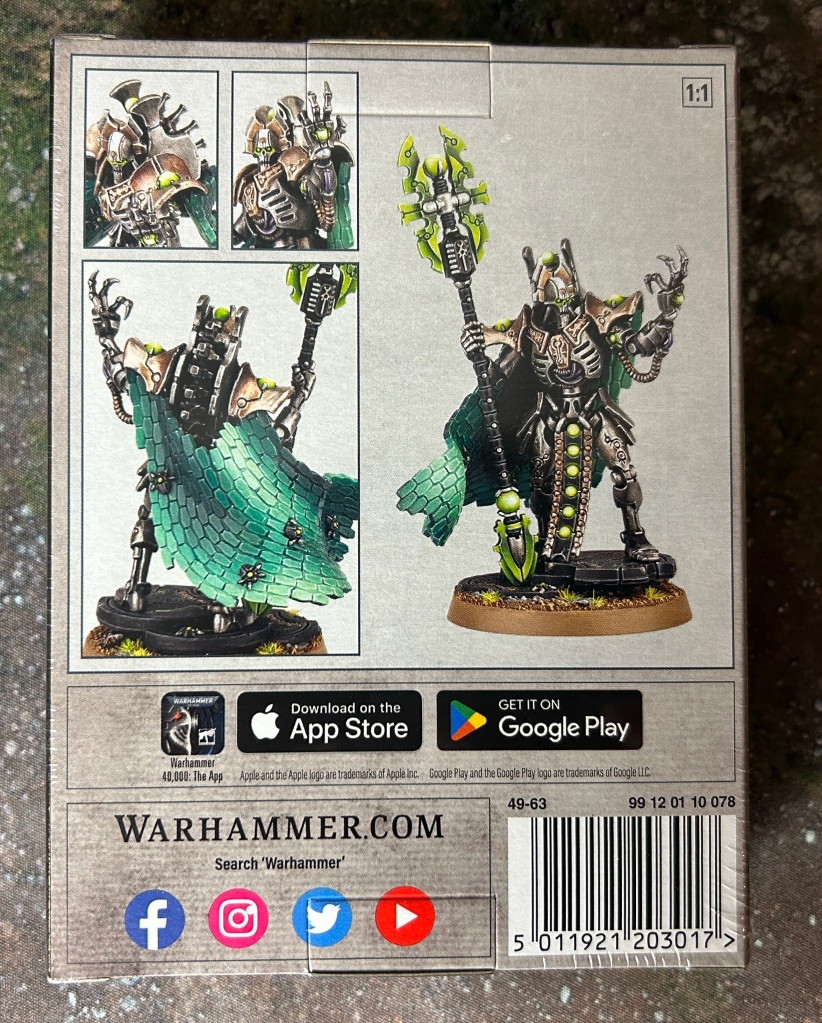Necrons | 2023 Codex Review & New Models Unboxed | Warhammer 40,000 10th Edition
You can find the brand new Necron Codex and the three brand new models up for preorder right now. Why not save some pennies and help us out massively by preordering through one of our Element Games links, like say, this one right here!
Hello and welcome to my (Dave) first 10th Edition Codex review for Warhammer 40,000, the Necrons!
I’m relatively new to Necrons, picking up my first models following the Indomitus box for 9th Edition, and instantly fell for the army. Resurrecting warriors? Gauss weaponry? Massive floating temples? Aww yeaah! So when the new Codex landed at Sprues & Brews HQ, along with the three brand new models, I jumped at the chance to take them on.
Our thanks to Games Workshop for sending us the Codex, Imotekh the Stormlord, Orikan the Diviner and the new Overlord with Translocation Shroud to build, paint and review for you folks!
Matt has reviewed the other new Codex which is out today, the Adeptus Mechanicus! You can check out his review here. We also have a very exciting video on the way featuring both of these armies, so stay tuned to our social media!
Before we check out the codex, let’s have a look at the three minis accompanying the book.
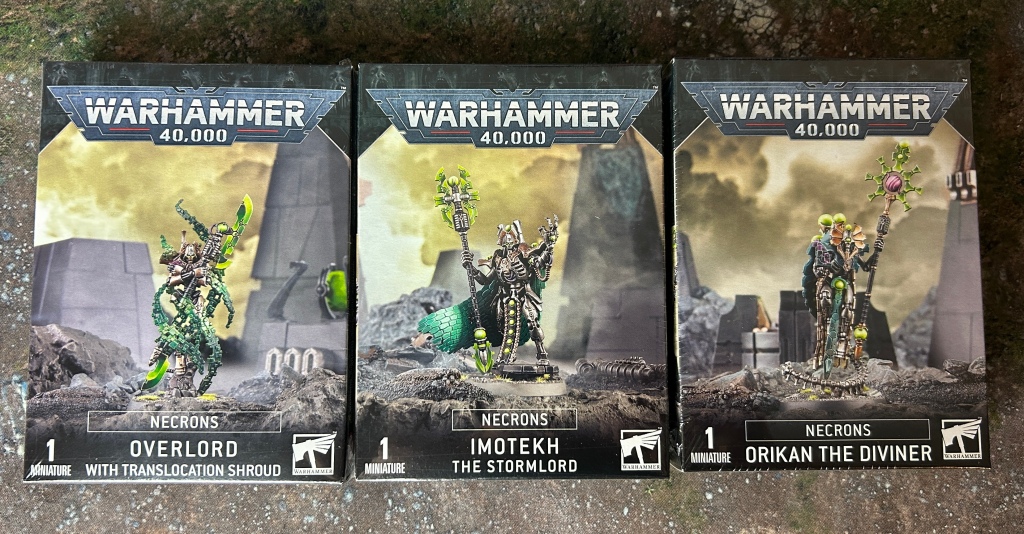
Overlord with Translocation Shroud
Whilst normally I’m more of a fan of a dynamic combat-style pose, I really liked the look of this new Overlord as soon as it was revealed. With parts of the model missing as it phases out of existence I expected that the model would be quite complicated to build and paint, but honestly, I had very issues. In fact, the model only comes in 5 parts and is really easy to assemble. Even the neck part which looks like it could be a little tricky fits really well.
I didn’t really struggle to get to any parts of the model with the brush either, as I can’t imagine anyone would want to do this guy in sub assemblies.
You can check out the sprues, as well as the mini built and painted below:
Orikan the Diviner
This guy is easily my favourite of the three models, and it is great that one of the classic characters has returned in plastic.
Out of the three he is probably the ‘hardest’ to assemble, but even then he wasn’t too bad at all. He comes in a fair few parts, but like with most new plastic minis it went together really well. He was also very fun to paint, with lots of cool details (and a very cool staff!).
Again, you can find pictures of the sprues and the model built and painted below:
Imotekh the Stormlord
And finally we have one of the leading legends of the Necrons (behind The Silent King, of course…), Imotekh the Stormlord.
Again, a really enjoyable build, albeit with a few small pieces. I like the fact his stance is very similar to the previous version. Sadly I didn’t quite get round to painting him, but at least he’s assembled and undercoated!
Shots of his sprue and assembled mini are below:
With the new minis out of the way…it’s time to check out the codex!
Codex Necrons Review
The Necrons are only the third Codex of 10th Edition, which can be both a blessing and a curse. A blessing because fans of the race haven’t had to wait long for a brand new book, but a curse as sometimes the books can take a little time to ‘settle’ into the edition.
So let’s break down the new book and see what it brings to the table…
General Presentation
First and foremost, I really like the presentation style of the 10th Edition books. Yes, they aren’t a million miles away from the style of the 9th Edition books, but they have really tightened up the layout, contents and style.
The points for the models are still in the book, however you also get a handy QR square to scan which will take you straight to any updated points for the Necrons on Warhammer Community.
Lore
As with all Warhammer 40,000 Codexes, the book opens with an Introduction and then straight into the lore of the Necrons.
The book makes a fantastic introduction to anyone who wants to collect the Necrons for the first time, but also veterans will find a fair bit of new content in here too. For me the book gave me a lot of new details on the different Dynasties of the Necrons, which is great. Theirs plenty of background for the special characters too, to really give you a feel for the army.
You’ll also be able to catch up with more recent goings-on, including the Pariah Nexus.
I’m not going to go into a great amount of detail, as I wouldn’t want to spoil anything, however I was really impressed with the content, it’s the best lore I’ve read in a Codex so far.
Combat Patrol
One of the best new features of the new Codexes is the introduction to Combat Patrol. For a while now the Combat Patrol boxes have mainly been a quick way to start an army, giving you a core selection of units to get you going.
Nowadays, the Combat Patrol is much more than that, it is an easy way to get into small games of Warhammer 40,000. In the Codex you get unique rules for all the units in the box, as well as general rules for the army. Now these rules can only be used in games of Combat Patrol, but most of the rules are the same as the full datasheets, only with a little more narrative flavour.
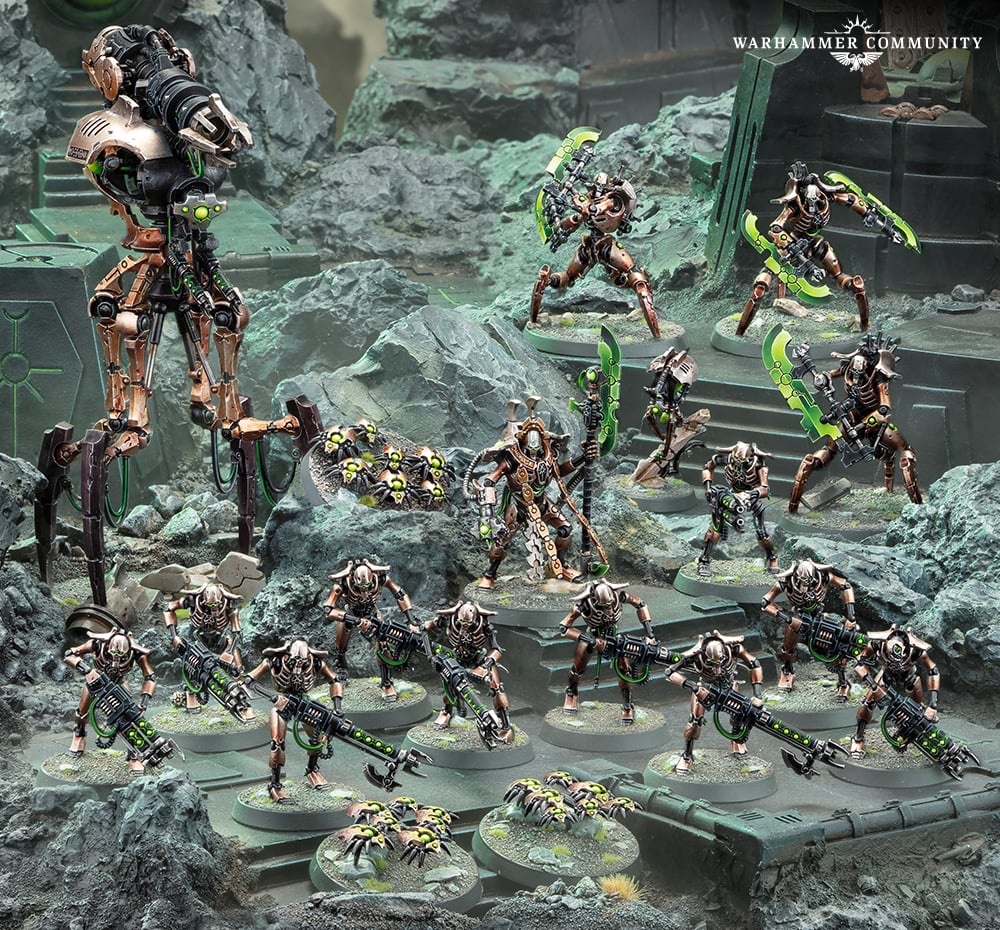
You also get unique Enhancements, Stratagems and Secondary Objectives. It’s really given me a nudge to have a few games of the smallest scale 40k you can play.
Aside from gaming, you also get a guide on painting your Combat Patrol too.
I can’t remember the last time a Codex has had such a brilliant way of introducing new players to an army and the game. Great addition to the Codex.
Detachments
Aside from the Datasheets, the Detachments are probably one of the most important parts of the new 40k Codexes. These have replaced the old army rules that we used to have.
Each one leans into a different playstyle and most favour a particular type of unit(s) from the army. The Detachment from the Necron Index returns, along with 4 other detachments.
We are going to break down each of the 5 detachments, but before that a note that the general army-wide rule, Reanimation Protocols, returns from the Index and has gone unchanged.
Awakened Dynasty
These are the same set of detachment rules that came with the Index, albeit with some changes.
The Detachment Rule is identical. By attaching a character to a unit the whole unit adds 1 to the Hit roll. This is huge, and arguably is the best Detachment rule in the book. When I look at the other detachments I constantly think back to this singular rule.
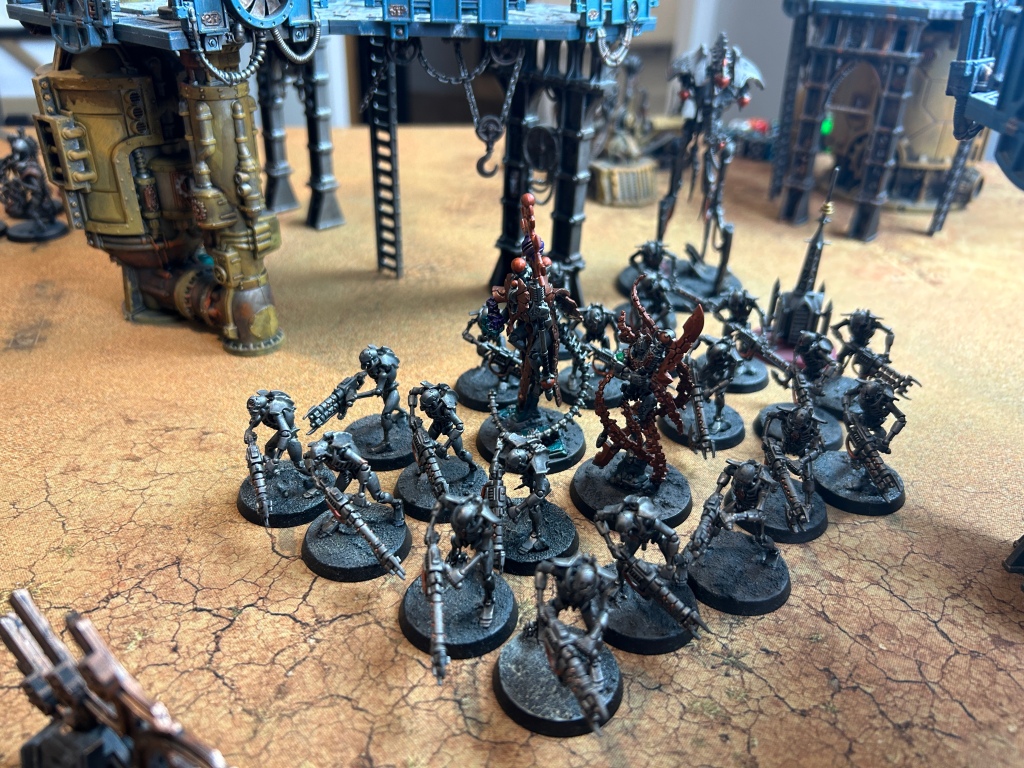
The Enhancements have slightly changed. Returning from the Index are the Veil of Darkness (exactly the same ruling), as well as Sempiternal Weave (although the rule is the same it is now called Enaegic Bond). The Sovereign Coronal is also back, but with a new name (Phasal Subjugator) and a slight re-wording, but in essence it grants a +1 to Hit Aura for Necron units (but now not Charaters) within 6″. Ideal for giving a bonus to hit to some of your Vehicles.
Moving on to the Detachment’s Stratagems, again, not much has changed bar some slight re-wording and some changed names. Protocol of the Eternal Guardian (now Eternal Revenant) is a great example. Same effect (bring a character back to life with half wounds remaining) only with a clearer definition of where said model reappears (as close to where they died, but outside of Engagement Range).
If you play lots of Warriors and Characters, then this is hands down the most reliable of Detachments and is very hard to ignore. Necron Warriors hitting on 3s is sooo much better than hitting on their base stat of 4s. The Detachment rule is very hard to ignore.
Annihilation Legion
We move on to the brand new detachments for this book. The first, if the name didn’t give it away, concentrates on those of us who love to get stuck into combat and favour the use of Skorpekh Destroyers and Flayed Ones.
To that end the Detachment rule, Annihilation Protocol, is pretty straight forward. Your Destroyer Cult and Flayed One units get to re-roll charges. Should a unit you are charging be under Half-Strength you get to add 1 to the Charge too. Tasty!
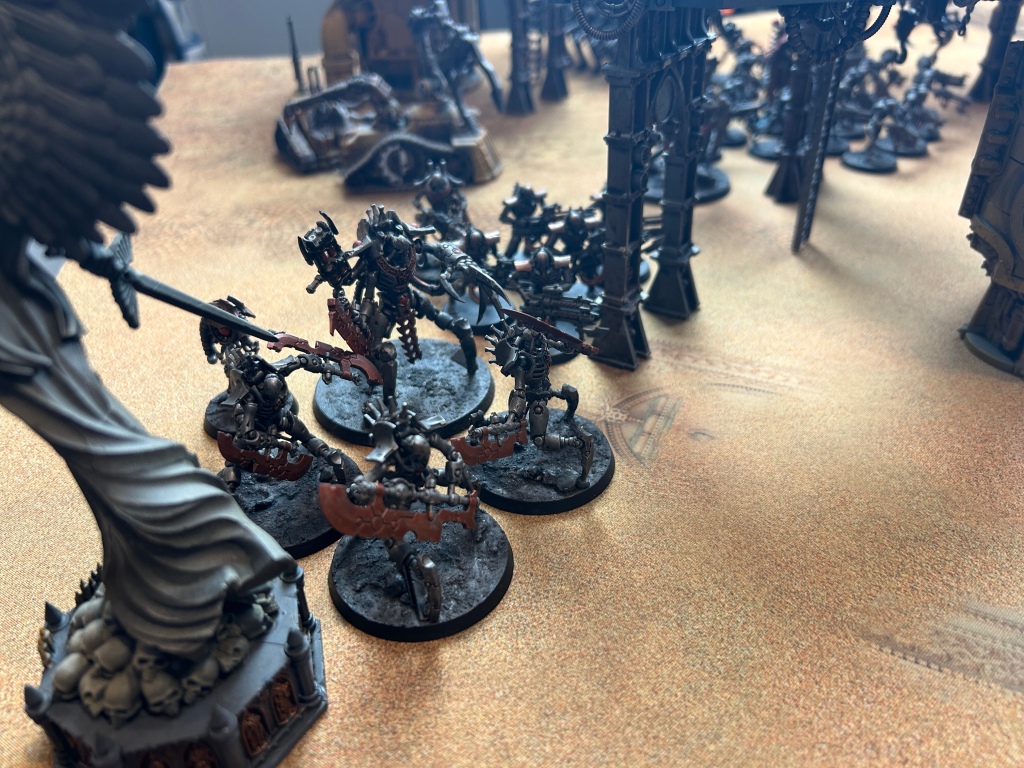
The Enhancements are very suited to this detachment. Eternal Madness allows models in the unit to fight on death on a 4+ and Ingrained Superiority grants an additional pip of AP on a Critical Wound roll (note it doesn’t say in any particular phase, so counts in both shooting and combat). These I would say are the strongest enhancements, however the other two are still pretty handy.
Soulless Reaper stops a unit from falling back on a 3+ whilst Eldritch Nightmare forces your opponent to take a Battle-shock test on the unit stuck in combat with the bearer’s unit.
Again, the Stratagems help to fuel your army in combat. These include making a friendly unit -1 to hit (works in both shooting or combat), make a 6″ pile-in rather than the normal 3″ and the aptly titled Murderous Reanimation, which allows you to activate Reanimation Protocols after a Destroyer or Flayed One unit either destroys an enemy unit or makes the unit go under Half-Strength.
My two favourites however are Insanity’s Ire, which not only is a cool name for a strat, but also allows you to move a Destroyer Cult or Flayed One unit to move towards an enemy unit in your opponents turn should they successfully wound said unit (I believe the Tyranid’s Carnifexes have a similar rule, only on their Datasheet instead of a strat). My overall favourite though is The Spoor of Frailty. Again, only usable on a Destroyer Cult or Flayed One unit, this strat grants +1 to Hit if the enemy unit in combat is below Starting Strength and an additional +1 to Wound should the unit be also below Half-Strength.
It goes without saying really that if you just love your Destroyers and Flayed Ones, then this is the Detachment for you. It would have been nice however to have a strat that could have helped to buff say, Lychguard, in combat, however they have their own detachment which we shall cover soon.
Canoptek Court
Bet you cannot guess what this Detachment is aimed for… That’s right, those who love to field a whole bunch of Canoptek units and Crypteks.
These are a very interesting set of rules, none more so that the overall Detachment Rule, Power Matrix. Certain areas of the battlefield come under the effects of the Power Matrix. Many of the strats play off whether you are in or out of one of these areas. Those areas are:
- Deployment Zone is always within the Power Matrix
- At the start of any phase, should at least half of the objectives within No Man’s Land be under your control, then No Man’s Land also falls into your Power Matrix.
- Finally the same goes for your opponent’s deployment zone. Should you control at least half of their objectives, then that zone falls in to your Power Matrix.
If you have played with or against Chaos Daemons then this rule should be sounding pretty similar, as the Shadow of Chaos rule is basically the same.

Like with the other detachments, you have 4 unique Enhancements. In this instance, they all can only be taken by a Cryptek. All 4 have their uses.
Metalodermal Tesla Weave does mortal wounds to a unit that is charging the bearer’s unit, Dimensional Sanctum gives the character and unit Infiltrate whilst Autodivinator allows you to gain CP whenever your opponent uses an ability which grants them additional CP (handy for the cool strats we’ll be moving on to shortly).
My favourite however is Hyperphasic Fulcrum. Very straightforward, so long as the unit with the bearer is wholly within the Power Matrix you get to reroll Wound rolls of 1.
Moving on, it’s time to have a peek at the stratagems exclusive to this detachment. Theirs a couple of names here you’ll reconsigse from previous Necron rules.
The first one that jumps out is Solar Pulse, which allows a Cryptek to pick an objective within 18″. Any of your Necron units that fire at an enemy unit within range of said picked objective Ignore Cover, which is cool. Suboptimal Facade is usable at the end of your opponents Charge phase and allows you to Reanimate a Canoptek unit, handy if you have a wounded Canoptek unit about to get punched in the chops!
My favourite also has the coolest name, Curse of the Cryptek. You can use it in your opponent’s Shooting or Combat phase after one of your Canoptek models has been destroyed. Until the end of the battle, any attacks made by your Canoptek units make an attack against the unit that destroyed your model you gain +1 to Hit AND to Wound. Excellent!
Another one well worth mentioning is Cynosure of Eradication. This 2CP strat gives a Canoptek unit Devasting Wounds for that phase.
This is a detachment I really fancy trying out, mainly because the Canoptek units are very cool anyway, and I think their is some fun to be had with a number of the Enhancements and strats, not to mention expanding your Power Matrix, I personally love mechanics like that!
Obeisance Phalanx
Not a big fan of hordes of Warriors? Or Canoptek units? Or Destroyer Cults?
Well…how about Overlords, Prateorians, Triarch Stalkers and Lychguard?
If so, then whatdyaknow, theirs a detachment for you too!
So what does this Detachment bring to the table? Well let’s kick things off with Worthy Foes, the special detachment rule. In the Command phase you can choose one enemy unit on the board. All of your Overlords, Triarch and Lychguard units gain +1 to Wound against said enemy unit.

All of the Enhancements can only be given to an Overlord, and you’ve got some interesting choices here. Honorable Combatant is a cool way of gaining some additional CP. Everytime your Overlord or his attached unit kills an enemy character you gain an extra CP.
Unflinching Will turns your Overlord into a character assassin, as it gives his melee weapons both Anti-infantry 5+ and Precision. Warrior Noble makes your Overlord’s unit a little more defensive, making them -1 to Hit (albeit only in melee).
Saving the best Enhancement until last though. Eternal Conqueror is a very cool buff for your Overlord and his unit. When they target an enemy unit within range of an objective marker you get to reroll ALL hit rolls.
So what about the strats? Well you’ll be pleased to hear we have yet again a good selection to choose from. Your Time is Nigh sounds epic, but it isn’t as flashy as the name suggests but is still cool. You can use it once you have taken down the enemy Warlord all of your opponent’s units have a -1 modifier to their Battle Shock and Leadership tests.
Enslaved Artifice however is punchy. You can use it on a unit that hasn’t yet shot in the shooting phase, or fought in the Combat phase. Critical hits go off on 5+ rather than 6s, which is sweet for those Lethal Hits!
Suffer No Rival will have your opponent worrying about their characters. The strat is usable on a Lychguard or Triarch unit and gives them Precision. If you like a fight on death ability, then their is a strat for that called Sentinels of Eternity. Again only usable on a Triarch or Lychguard unit, but it basically gives them a chance to fight after they die (activated per model on a 4+ as they are destroyed).
This detachment has the feeling of an army wanting to take out key targets in your opponent’s army. It is probably my least favourite of the detachments if I’m completely honest, but I feel like some will really like it and it could see some use.
Hypercrypt Legion
Aside from the Awakening Dynasty detachment Warhammer Community have been shouting about the Hypercrypt Legion, and with good reason, because in my opinion for general army builds this is up there with the Awakening Dynasty.
So, the detachment rule for this one is very cool. It’s called Hyperphasing and it allows you to remove X number of units from the battlefield at the end of your opponents turn and place them into Strategic Reserve to then bring back in to play at the end of your next Movement phase. I say X because the number of units you can do this to depends on the size of the game you are playing. If you are playing a Incursion sized game (1000pts) then you can do this to 2 units. If you are playing a Strike Force sized game (2000pts) you can choose up to 3 and finally if you are playing a Onslaught sized mega-game (3000pts) you can choose up to 4.
Couple of things to quickly remember. Units in Strategic Reserve can only come on from the board edges unless they have the Deep Strike ability (which in that case they can Deep Strike with the normal restrictions). By being able to hyperphase at the end of your opponents turn is great for two reasons:
- It means that, should you be playing Tactical Objectives, you’ll be drawing your cards in your Command Phase and will have a unit or two off the board and potentially able to come on and achieve a card you’ve drawn, say for example Investigate Signals.
- Secondly, and this one is very obvious, it gives you so much mobility. You can completely mess with your opponents plans.
Now, the only thing the units that are sat off the board miss out on is your next Command Phase, and importantly this includes Reanimation Protocols. However, you’ll be pleased to hear their is a way around this.
So that is the core detachment rule explained, what about the Enhancements you can choose from.
- Dimensional Overseer is pretty simple, It allows you to add an additional unit to Hyperphase (so for an Incursion sized game you’d be able to choose up to 3 instead of 2). The bearer does however need to be on the battlefield to be able to use this abillity.
- Arisen Tyrant grants the bearers unit reroll Hits of 1. In addition to this, should the unit have arrived on the battlefield that turn (say, from Hyperphasing…see what they did there) then you get full rerolls to Hit.
- Hyperspatial Transfer Node is…OK. It’s the same ability as the new Translocation Shroud on the Overlord. You can auto advance 6″ instead of rolling.
- We do finish on a very strong enhancement, the Osteoclave Fulcrum. This grants the bearer and his unit the Deep Strike ability. Great anyway, but even better when you remember you can Hyperphase!
That’s a great selection of Enhancements, now let’s crack on with the available strats.
Quantum Deflection is a returning name, but has a slightly different ability. It now grants a Necron Vehicle a 4+ invulnerable save. Cosmic Precision allows you to arrive from either Deep Strike or Hyperphasing outside of 3″ instead of 9″, with the only caveat being you cannot Charge,
Reanimation Crypts gets around you missing the Reanimation step from your Command Phase. You have to target your Necron Overlord with the strat, but it then allows you to Reanimation Protocols on all of your units in Strategic Reserve. The final strat I’m going to mention is Entropic Dampening. It costs a CP and targets one of your Titanic units. Whenever an enemy unit shoots it within 18″ that said unit gains the Hazardous keyword. That is seriously cool!
This will 100% be the next detachment I use, it looks so fun. It should make secondary objectives a tad easier to nab as well.
Datasheets
Now normally, when I write these Codex reviews the Datasheets are where I spend the most time. However, that really isn’t the case for this review.
The reason for this, as we should all expect really, is that I cannot really find any changes from the Index rules. GW did say that they would avoid changing any Datasheets between the Index rules and the Codex, unless something needed to be done.
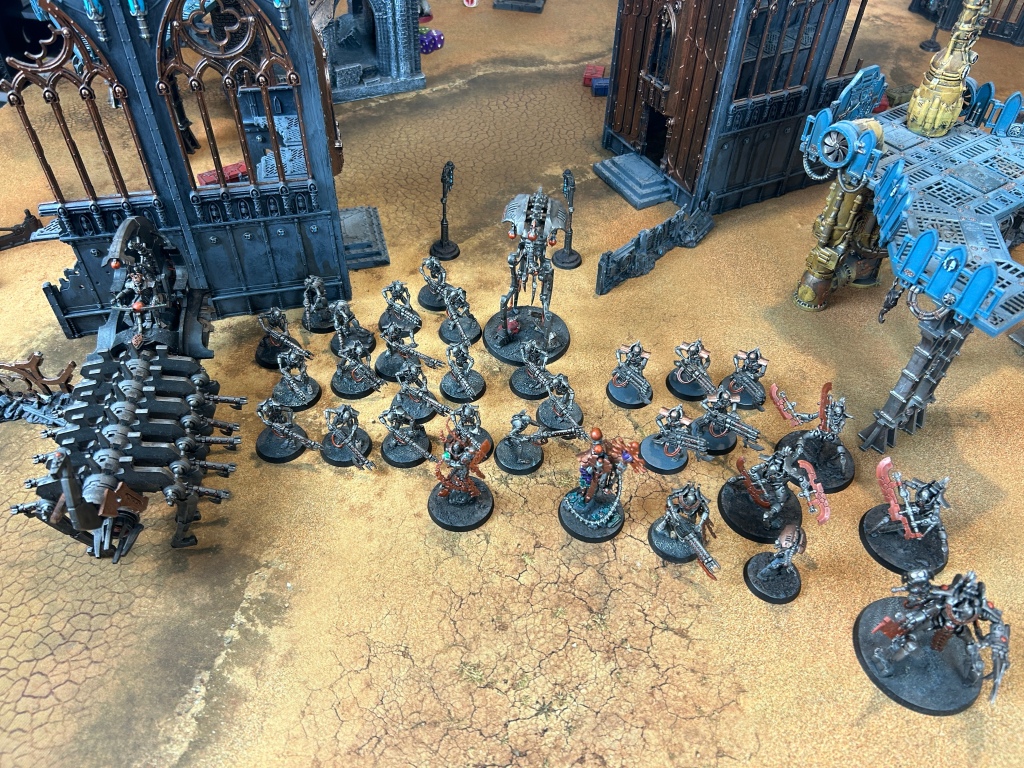
One key thing that I did notice was the Resurrection Orb has changed. It has returned to being a once per battle ability that now can be used during any phase, and instantly initiates Reanimation Protocols on the Overlord’s unit, rezzing D6 wounds rather than D3.
I know from being part of a large Necron group on Facebook that a number of people spotted from WarCom posts that it appeared some datasheets were going, or were being phased into one datasheet.
Well…it’s true…some units have gone. The following characters have unfortunately been removed…
- Anrakyr The Travellor
- Vargard Obyron
- Nemesor Zahndrekh
- Lord
Yup, they’ve all gone to Legends sadly. Hopefully one day in the future we’ll see them return with new kits. The Lord is probably the least likely as I always wondered why we had Overlords and Lords when they really are the same thing IMHO.
What I am very hopeful for is a new Trazyn the Infinite, as he is now the only model not to have a plastic kit.
Crusade
And so we move on to the final part of the book, Crusade!
We are massive fans of Narrative here at Sprues & Brews, so it’s fantastic to see GW to continue to push Crusade in 10th Edition, as it wasn’t mentioned much in the run-up to the edition.
Their are less options than previous, but what is here has been tightened up a bit.
The premise is you are a newly awakening force. The main mechanic centres around three tech trees, the Command System, Reanimation System and Translocation System. You then have 3 Awakening Points, which can be spent on said tech trees to unlock different abilities. However, to use them you need to complete Agendas. These also help to gain XP for your characters and units.
To further help with gaining XP you’ve got a number of narrative Agendas to complete. You can then spend your hard earned resources on Requisitions, gain Battle Traits and further awaken your tomb world!
Oh, and if your units get destroyed their is a chance you can gain Battle Scars, which is returning.
What is new is that, once you have achieved certain points during your Crusade you then unlock a Campaign badge, which is very cool. Theirs three to collect, and I’m not going to lie, I want them to release a little transfer sheet for these!
Summary
So that brings this look at the brand new Necron Codex to a close. So what do I think?
These Codexes feel…different…in a good yet surprising way.
For newcomers the Codex is brilliant. The lore clearly defines what the Necrons are about and what they are up to nowadays. The introduction to a section for Combat Patrol is a real bonus as well for newbies, as well as being what appears to be a very fun way of playing some skimishes of 40k. It certainly has pushed me to paint a couple of Combat Patrols just to try out some different factions!
For returning players the new Detachments offer different ways to play the army. If you have a favourite type of unit the chances are their is a detachment for you. For me however, the Awakened Dynasty has the simplest yet almost impossible to ignore Detachment rule, which makes picking some of the other detachments a little harder than it should be.
I personally cannot wait however to try out the Hyperphase Crypt, as well as the Annihilation Legion. They to me have a great balance of Enhancements and Stratagems (plus it probably helps that I love the models they lean in to!).
It’s almost odd that the Datasheets haven’t really changed, it almost feels like it’s not a new Codex at all! I sort of miss the surpraise of flicking through and seeing what has changed.
The new models are fantastic, in particular Orikhan. Rules-wise he comes out on top too, being a nice little buffed Chronomancer. The Stormlord is also a great buffing character who can still throw a few punches. The new Overlord with Translocation Shroud has his uses, but I’m not sure how much I’ll be using his Advance ability. In the Awakening Dynasty you do have a strat that turns your guns into Assualt which combos well with him however.
All-in-all, I really like the Codex, and I’m looking forward to taking my Necrons to more games. Pass me the Leadbelcher spray, I need to paint more Necrons!
Our thanks again to Games Workshop for sending us the Codex and models to review, and don’t forget to preorder through one of our Element Games links!

